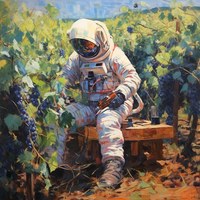NASA's Stellar Intervention: Saving the Cabernet Sauvignon Harvest
Posted by Matteo Lahm on 15th Aug 2023
In a celestial twist of fate, NASA has swooped in to save the day for home winemakers, particularly those with a penchant for Cabernet Sauvignon. The space agency, known for its interstellar explorations, has turned its gaze earthward, using its advanced technology to detect a costly infection in grapevines before it becomes visible to the naked eye.

Every year, a myriad of plant pathogens, including molds, bacteria, and viruses, decimate 15 to 30% of global harvests. Early detection is the key to transforming a doomed crop into a treatable one. Enter NASA's Jet Propulsion Laboratory in Southern California, which has developed an airborne science instrument capable of spotting the subtle signs of grape disease that wreaks havoc on crops to the tune of billions of dollars annually.
The focus of this celestial intervention is a viral disease known as GLRaV-3 (grapevine leafroll-associated virus complex 3). This insidious virus, primarily spread by insects, sours developing fruit and reduces yields, costing the U.S. wine and grape industry a staggering $3 billion in damage and losses each year. Traditionally, detection of GLRaV-3 has been a labor-intensive process, involving vine-by-vine scouting and costly molecular testing.
However, NASA's Airborne Visible/InfraRed Imaging Spectrometer (AVIRIS-NG) has been repurposed to help growers identify GLRaV-3 infections early and from the air. This instrument, which records the interaction of sunlight with chemical bonds, has previously been used to monitor hazards such as wildfires, oil spills, and air pollution.
In a celestial dance of science and agriculture, the AVIRIS-NG was mounted in a research plane and used to observe roughly 11,000 acres of vineyards in Lodi, California, a major producer of the state's premium wine grapes. The observations were then fed into computer models, which were trained to distinguish infection. The results were cross-checked with ground-based scouting and molecular testing.
The results were stellar. The models were able to differentiate between infected and non-infected vines both before and after they became symptomatic, with an impressive 87% accuracy. This early detection could provide grape growers with up to a year's warning to intervene, potentially saving their harvest.
This celestial intervention is a testament to the power of technology and collaboration. It's a story of how the stars aligned to save the Cabernet Sauvignon harvest, and a reminder that sometimes, the solutions to our earthly problems can be found by looking to the skies.

